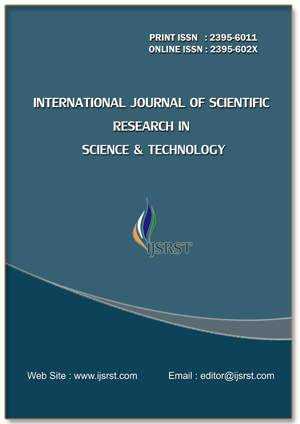Impact Assessment of Demographic Factors on Investment Objectives of Women
DOI:
https://doi.org/10.32628/IJSRST251222602Keywords:
Investment Objectives, Investment Decision Making, Women Investors, Demographic Factors, Financial SecurityAbstract
This study seeks to investigate the primary investing objectives of women and assess the influence of demographic factors on their financial objectives. The study employs primary data and utilizes Exploratory Factor Analysis (EFA) to classify investment objectives into meaningful factors. Furthermore, One-Way ANOVA is utilized to evaluate the impact of demographic characteristics, including age, education, income, marital status, occupation, and family structure, on investment objectives. The data indicate two principal investment objectives among women: wealth-building investments, which prioritize capital appreciation and long-term financial growth, and security-oriented investments, which emphasize financial safety, retirement savings, and family welfare. Findings demonstrate that marital status, income level, and the number of dependents substantially affect security-oriented investing decisions, while family responsibilities shape wealth accumulation objective. The study's findings enhance the discourse on gender-specific investment behavior and offer significant implications for policymakers, financial institutions, and educators to develop customized financial literacy programs and investment products that adequately meet the distinct needs of women investors.
📊 Article Downloads
References
Arun, S. V., Arun, T. G., & Borooah, V. K. (2004). The effect of career breaks on the working lives of women. Feminist Economics, 10(1), 65–84. https://doi.org/10.1080/1354570042000198236
Bartlett, M. S. (1950). Tests of significance in factor analysis. British Journal of Statistical Psychology, 3(2), 77–85. https://doi.org/10.1111/j.2044-8317.1950.tb00285.x
Bhattacharyya, R. (2024, January 17). 51% of women in India prefer low-risk financial instruments; only 7% invest in stocks: Survey. The Economic Times. https://economictimes.indiatimes.com/jobs/hr-policies-trends/51-of-women-in-india-prefer-low-risk-financial-instruments-only-7-invest-in-stocks-survey/articleshow/106924216.cms
BFSI, E. (2025, February 5). Women’s participation in stock markets rising since 2022, Delhi leads with 30% share: NSE. ETBFSI.com. https://bfsi.economictimes.indiatimes.com/news/financial-services/womens-participation-in-stock-markets-rising-since-2022-delhi-leads-with-30-share-nse/117941027
Charness, G., & Gneezy, U. (2011). Strong evidence for gender differences in risk-taking. Journal of Economic Behavior & Organization, 83(1), 50–58. https://doi.org/10.1016/j.jebo.2011.06.007
Contributors, E. (2024, March 8). The rise of women in entrepreneurial roles in India. The Economic Times. https://economictimes.indiatimes.com/small-biz/entrepreneurship/the-rise-of-women-in-entrepreneurial-roles-in-india/articleshow/108317138.cms
ET Bureau. (2025, March 28). Women’s workforce participation rose to 25% in 2024, says report. The Economic Times. https://economictimes.indiatimes.com/jobs/hr-policies-trends/womens-workforce-participation-rose-to-25-in-2024-says-report/articleshow/119671524.cms
Hair, J. F., Babin, B. J., Anderson, R. E., & Black, W. C. (2019). Multivariate data analysis (8th ed.). Pearson Prentice.
Hair, J., Black, W., Babin, B., & Anderson, R. (2010). Multivariate data analysis: A global perspective.
Jain, J., Walia, N., Kaur, M., Sood, K., & Kaur, D. (2023). Shaping investment decisions through financial literacy: Do herding and overconfidence bias mediate the relationship? Global Business Review. https://doi.org/10.1177/09721509221147409
Kaiser, H. F. (1960). The application of electronic computers to factor analysis. Educational and Psychological Measurement, 20(1), 141–151. https://doi.org/10.1177/001316446002000116
Kaiser, H. F. (1974). An index of factorial simplicity. Psychometrika, 39, 31–36. http://cda.psych.uiuc.edu/psychometrika_citation_classic_summaries/kaiser_citation_classic_factor_simplicity.pdf
Lusardi, A., Mitchell, O. S., & National Bureau of Economic Research. (2013). The economic importance of financial literacy: Theory and evidence. In NBER working paper series (Working Paper 18952). National Bureau of Economic Research. https://www.nber.org/system/files/working_papers/w18952/w18952.pdf
Mishra, P. R., & Kumar, S. (2025). The impact of technological advancements on investor decision-making and stock market efficiency: A comprehensive analysis. Journal of Informatics Education and Research, 5(1). https://doi.org/10.52783/jier.v5i1.2403
Nathanson, M. J., Craig, J. T., Geoghegan, J. A., Lee, N. G., Haber, M. A., Haspel, M. B., Hieken, S. P., Ilteris, M. C., McDonald, D. S., Salvati, J. A., & Stelljes, S. R. (2021). Achieving financial independence: Goals-based planning. In Springer eBooks (pp. 73–90). https://doi.org/10.1007/978-3-030-65400-9_6
Nunnally, J. C., & Bernstein, I. H. (1994). The assessment of reliability. Psychometric Theory, 3, 248–292.
Oginni, O. (2025, March 27). Council post: 3 factors that explain why women invest differently. Forbes. https://www.forbes.com/councils/forbesfinancecouncil/2025/03/27/3-factors-that-explains-why-women-invest-differently/
Park, S. R., & Jang, J. Y. (2021). The Impact of ESG Management on Investment decision: Institutional Investors’ Perceptions of Country-Specific ESG Criteria. International Journal of Financial Studies, 9(3), 48. https://doi.org/10.3390/ijfs9030048
Prasad, S., Kiran, R., & Sharma, R. K. (2021). Behavioural, socio-economic factors, financial literacy, and investment decisions: Are men more rational and women more emotional? The Indian Economic Journal, 69(1), 66–87. https://doi.org/10.1177/0019466220987023
Pti. (2021, March 7). Young women investors more likely to choose high-risk, high-return asset class: Survey. The Economic Times. https://economictimes.indiatimes.com/markets/stocks/news/international-womens-day-mar-8-2021-young-women-investors-more-likely-to-choose-high-risk-high-return-asset-class-survey/articleshow/81376392.cms
Rojas, A. (2025, March 13). What’s next for women and wealth-building? Forbes. https://www.forbes.com/sites/alejandrarojas/2025/03/13/whats-next-for-women-and-wealth-building/
Saini, R., & Habil, M. (2025). Women investors in the digital age: The impact of fintech on investment behavior. EPRA International Journal of Multidisciplinary Research (IJMR), 333–340. https://doi.org/10.36713/epra20575
Srivastav, S. K., & Jain, N. J. K. (2025). An empirical study of the factors affecting investment choice decisions of academic professionals. International Journal of Scientific Research in Science and Technology, 12(2), 244–257. https://doi.org/10.32628/ijsrst25122223
Srivastav, S. K., & Jain, N. J. (2024). Impact assessment of information technology on investment choice decisions of academic professionals. EPRA International Journal of Economics, Business and Management Studies, 52–59. https://doi.org/10.36713/epra18638
Srivastav, S. K., Habil, M., Thakur, P., Jain, J., & Saini, R. (2024a). Analyzing the influence of fintech & digitalization on investment choice decisions of mutual fund investors. International Journal of Research Publication and Reviews, 5(2), 2414–2415. https://doi.org/10.55248/gengpi.5.0224.0545
Srivastav, S. K., Habil, M., Thakur, P., Jain, J., & Saini, R. (2024b). Assessing the Impact of ESG (Environmental, Social & Governance) Factors on Investment Decisions among Academic Professionals. International Research Journal of Modernization in Engineering Technology and Science. https://doi.org/10.56726/irjmets49527
Statistics using IBM SPSS Statistics Discovering. (2013b). In SAGE Publications Ltd (4th ed.). https://www.sagepub.com/sites/default/files/upm-binaries/52063_00_Field_4e_SPSS_Prelims.pdf
Suresh G. (2021). Impact of Financial Literacy and Behavioural Biases on Investment Decision-making. FIIB Business Review, 13(1), 72-86. https://doi.org/10.1177/23197145211035481
Tavakol, M., & Dennick, R. (2011). Making sense of Cronbach’s alpha. International Journal of Medical Education, 2, 53–55. https://doi.org/10.5116/ijme.4dfb.8dfd
Towers-Clark, C. (2024, January 22). Women’s financial inclusion—Time to ignore men (and their data). Forbes. https://www.forbes.com/sites/charlestowersclark/2024/01/22/womens-financial-inclusiontime-to-ignore-men-and-their-data/
Women live longer than men in every country in the world. (n.d.). Our World in Data. https://ourworldindata.org/data-insights/women-live-longer-than-men-in-every-country-in-the-world
Women’s World Banking. (2025, February 25). How women's financial inclusion contributes to financial stability and soundness. Women’s World Banking. https://www.womensworldbanking.org/insights/how-womens-financial-inclusion-contributes-to-financial-stability-and-soundness
Downloads
Published
Issue
Section
License
Copyright (c) 2025 International Journal of Scientific Research in Science and Technology

This work is licensed under a Creative Commons Attribution 4.0 International License.
https://creativecommons.org/licenses/by/4.0




